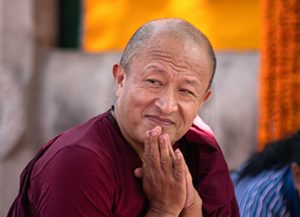Young Voices is a special project from Buddhistdoor Global collecting insightful essays written by high school students in the US who have attended experiential-learning-based courses rooted in the Buddhist teaching. Running in parallel with BDG’s Beginner’s Mind project for college students, Young Voices offers a platform for these students to share essays expressing their impressions and perspectives on their exposure to the Buddhadharma and its relationship with their hopes, aspirations, and expectations.
Bianca Morales wrote this essay for her Global Buddhisms class at Phillips Andover, a high school in Massachusetts.

How Giving Up My Phone Changed My Life
How do you go from six hours of screen time a day to zero? It’s easy: give up your smartphone. At least, that’s what I did for my Global Buddhisms class for a month. Turning my device in was the easy part, but what came after was more challenging.
The biggest adjustment was having no social media. We are living in an age of social media, and, according to Instagram, I have more than 1,000 friends—which I don’t think is true in real life. But it feels good and it replicates a sense of community to comment on people’s posts and reply to each other’s stories. When I had my phone, I regularly deleted and reinstalled Instagram, Snapchat, and Twitter as I felt it benefitted my mental health during my high school career, but not even having the option to log into Instagram and scroll was different.
To be completely transparent, I logged into Instagram and Twitter on my computer a few times. Partly because I wanted to scroll instead of think, but mostly because it’s how I connect with people and I wanted to maintain my friendships. Later, I found that most of my friendships on social media would be fine, precisely because they are, by their nature, superficial and can be picked up where I left off. Meanwhile, the non-superficial relationships that I was concerned about maintaining were strong enough to rely solely on the in-person connections I had with these friends, and that wasn’t an issue either.
Besides social media, I had to identify the other causes of dukkha—the things that bring me dissatisfaction—in my life. In Global Buddhisms, my teacher explained the Four Noble Truths to the class, organizing them in a square table divided into four segments. While I assume that this table was meant to offer a trick for memorization, I found that the equality of these squares that contained the Four Noble Truths also had a metaphorical accuracy: each of the truths relies on the others and are therefore equal to each other in importance.
For example, the cause of dukkha is one of the same with dukkha, with nirvana, and with the cause of nirvana. To achieve nirvana, you need to experience, understand, and work through dukkha. And in experiencing dukkha, you are trying to achieve nirvana (perhaps unknowingly), in the sense that you want to free yourself from suffering.
Given that all human beings want to be happy and that no one wants to suffer, and that all the Four Noble Truths hold equal significance, the next thing to figure out is how to realize one of the truths. One can study the cause of dukkha through articles and stories, but only attain a surface level comprehension. Only through living with a focus on the cause of dukkha can one really fathom it.
It wasn’t until my teacher introduced us to two Buddhist readings that I began to think more deeply about how this topic related to my relationship with my smartphone. The first was Mingyur Rinpoche’s In Love with the World. The second, a children’s book titled Shantideva: How to Wake Up a Hero.
The passage from Rinpoche’s book explained the Tibetan saying about adding wood to a fire. Adding wood to the fire is when someone gradually introduces hardships into their life with the intention of working through them. It’s a separate approach from the seemingly simpler decision to avoid difficult situations. The children’s book explained how an emotion, for instance anger, controls people. They use the example of an angry monk attacking another person with a stick—the way the person would typically not be upset with the stick demonstrates how they should also not be upset with the monk, but instead understand that anger commands the monk.
This made me think about the roots of my dissatisfactions with all the worldly things I previously mentioned. In other words, I began to reflect on my emotional attachments to each of the things in my life causing me dissatisfaction and how to confront these problems.
I didn’t get it completely right at first. I assumed that a huge cause of dukkha for me was that I was too focused on my perception of myself, and that by getting rid of my smartphone I would be forced to live in the moment and become more intimate with my own thoughts, instead of hyper-focusing on crafting an image of myself.
While it’s true that I was preoccupied with my reputation, I tried to desensitize myself to it by dropping distractions and forcing myself to confront the issue. Perhaps this was a good first step, but I hypothesized that it would end there. Now, I understand that desensitization was only one part of a puzzle that I would be piecing together to confront this insecurity of self-image.
I tried to think introspectively, realizing that my phone offered me the ability to filter my raw emotions. Having my smartphone allowed me to saturate and concentrate on one emotion, instead of feeling everything as it occurs naturally. Through walking on the paths with no phone, and therefore no music, I learned that a rainy day doesn’t have to be gloomy. This was news to me. Prior to surrendering my phone, I would indulge in my expectation that solemnity accompanies gray, chilly days by listening to sad music while walking to my classes, or engaging in a culture of aesthetic sadness cultivated on social media.
Of course, because I curated my circumstances to reflect sadness, I would become sad, but I was never inherently somber. As I walked down the paths of my boarding school without my phone, I appreciated the small, gentle impact of each cold rain droplet landing on me and the way the sun still illuminated the sky despite being suffocated by thick clouds.
Giving up my smartphone allowed me to achieve a new level of emotional and practical clarity. I can’t say that I have found the cause of dukkha yet, or any of the Four Noble Truths, but I can say that this exercise significantly improved my quality of life. Adding wood to the fire is something I will continue to practice in my daily life. And I recommend to anyone reading that you should try it too!
References
Mingyur Rinpoche, Yongey. 2019. In Love with the World: A Monk’s Journey Through the Bardos of Living and Dying. New York: Random House.
Townsend, Dominique. 2015. Shantideva: How to Wake Up a Hero. Boston, MA: Wisdom Publications.
Related features from BDG
Phone Fasting
On My Life as a Smartphone-less High School Student














